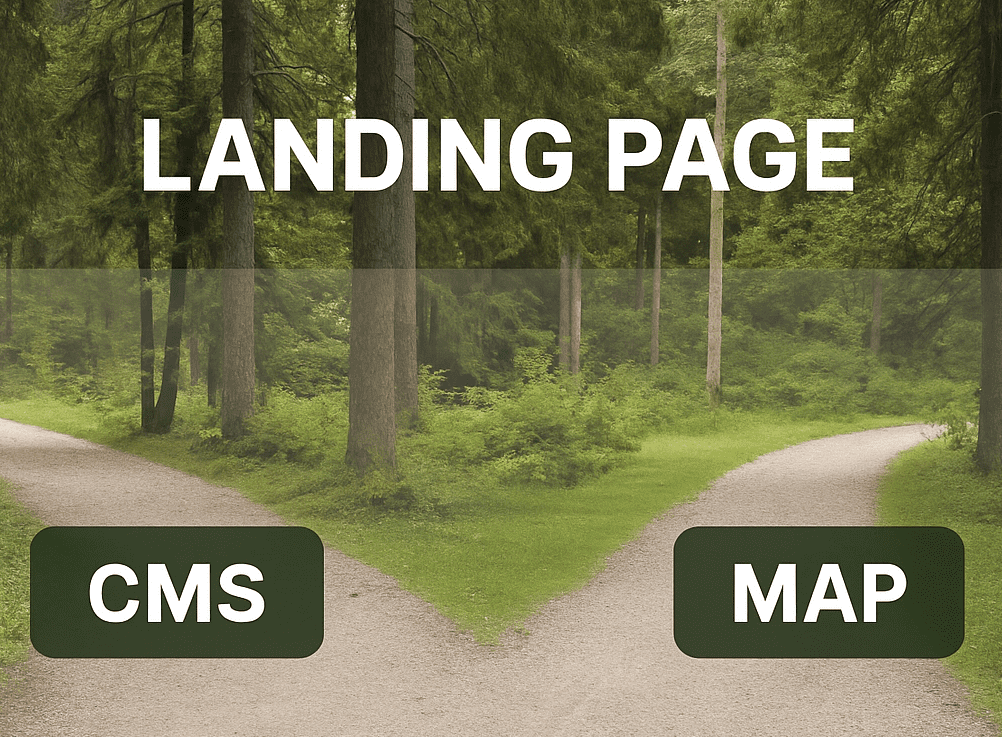CMS or MAP? The Landing Page Hosting Debate

Summary
Marketers often treat the choice between CMS and MAP-hosted landing pages as a technical decision. But it’s actually a signal of GTM clarity. This post reframes the debate and offers a strategic lens for smarter, faster, and more consistent insight delivery.
Marketers often debate where to host gated landing pages, on the company website or inside a marketing automation platform (MAP). On the surface, it’s about convenience versus control. But in truth, this is a GTM maturity issue.
Your choice of where gated content lives reflects how well your systems, teams, and reporting are aligned or how misaligned they really are. In this post, I’ll show why this choice reveals deeper revenue marketing dysfunction, why it matters more now than ever, and how to solve it strategically, not just tactically.
This Isn’t Just a Technical Decision. It’s a Strategic Signal
Landing pages sit at the intersection of branding, engagement, and conversion. Where you host them ripples across your entire funnel:
- CMS (Website): Branding control, SEO consistency, long-term content equity. But it usually needs dev time, delaying campaign speed.
- MAP (e.g. Marketo, HubSpot, Salesforce Marketing Cloud): Fast, templatized, owned by marketing. But often lives on a separate subdomain with limited customization and fragmented analytics.
If you’re reading this, you’ve probably fought the same internal battle: launch fast or launch clean?
But here’s the thing, this isn’t just about speed or polish. As Heinz Marketing has shown repeatedly, these tactical decisions often stem from deeper strategic gaps especially when foundational campaign elements aren’t aligned. (Source)
The Deeper Problem: GTM Misalignment
Here’s what the CMS vs. MAP hosting debate usually reveals:
-
Fragmented Reporting
Data lives in different tools. Your web team tracks sessions and form fills in GA or Hotjar, while campaign teams pull MQLs and conversion rates from Marketo. The result? No single source of truth.
-
Disconnected Campaign Execution
Your CMS owners can’t (or won’t) prioritize landing pages for marketing, so MAP becomes your default. But branding suffers, testing slows down, and nobody’s happy.
-
Inconsistent Lead Routing
Data flows differently depending on form source. That breaks lead source attribution and hurts SDR follow-up, nurturing logic, and campaign ROI reporting.
As my colleagues have emphasized in the personalization frameworks (source), even the best content won’t perform if it’s delivered through broken or siloed systems.
Why It Matters More Now Than Ever
The demand for precision marketing, fast reporting, and strategic alignment is higher than ever. But most GTM teams are still plagued by unclear ownership and underperforming martech.
When you don’t have clarity on something as fundamental as where to host content:
- You can’t trust campaign attribution
- You duplicate effort across teams
- You lose credibility with executives asking “what’s working?”
And as we’ve seen in our work on sales pipeline acceleration (source), clarity is not optional, it’s the engine behind high-performance teams.
How to Choose the Right Hosting Model (And Why It’s Not One-Size-Fits-All)
Here’s how to evaluate your hosting model based on your priorities:
Use Your CMS If:
- Branding and SEO matter most
- You can get dev resources on-demand
- You want full control over page experience and analytics
Tip: Embed MAP forms to ensure consistent routing and campaign tracking.
Use Your MAP If:
- You prioritize speed to launch
- You need to clone pages fast for segmented audiences
- You don’t have CMS support for landing page builds
Tip: Use a custom domain or subdomain to preserve some branding equity.
Use a Hybrid Model If:
- You want the best of both worlds: control, speed, and attribution
- You care about segment-level performance insights (e.g., ABM vs. global)
- You want to build executive-ready narratives from a unified data set
Hybrid model is one where you use either MAP or CMS for your landing pages, depending on your use case. This is exactly where a tool like Mperativ’s Agentic AI comes in. It’s not just about where a form lives, it’s about what your GTM data is telling you. Mperativ connects CMS, MAP, and CRM activity into clarity-generating executive narratives, eliminating the need to debate where data should live and finally focusing on what it means.
Final Thought:
If your team is stuck debating where gated content should live, it’s a signal, but not of incompetence, it is a signal of a system that’s out of alignment.
Don’t just decide where to put the next eBook. Ask:
- Can we track campaign source accurately across systems?
- Do we understand how each audience converts across different LPs?
Recommended Next Steps
- Run a quick audit of your gated asset workflow
- Build a hosting framework by funnel stage and persona
- Evaluate tools like Mperativ to centralize GTM reporting and reduce tactical churn
And most importantly: stop treating LP hosting like an IT problem. It’s a GTM performance problem. Solving it just might be the unlock your funnel’s been waiting for.
Ready to get started? If you’re looking to take your marketing strategy to the next level, reach out to us. Let’s talk about how we can help you implement the right LP strategy.
Image created using ChatGPT






